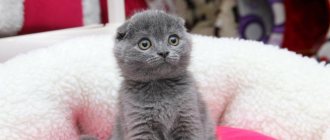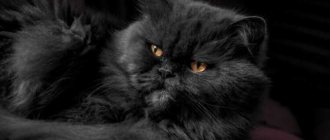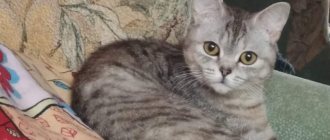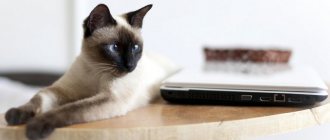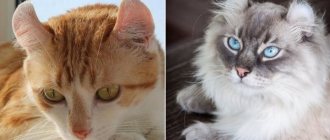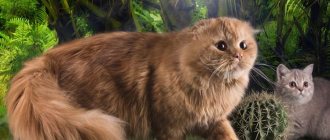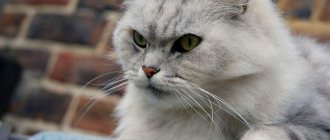Origin of the breed
The first mentions of Scottish fold cats were at the beginning of the 19th century in China. On the European continent they became known thanks to a farmer and his wife who lived in Scotland. The beginning of the breed was the ordinary cat Susie, born from ordinary street cats. She had short white fur and small forward-curved ears. The farmer's wife was breeding cats and drew attention to her. In 1961, the matured Susie gave birth to a kitten with the same curled ears. They named him Snooks. He became the founder of the Scottish Fold cat breed, both marbled and other colors.
The Rosses wanted to obtain official permission to breed these cats, but when they turned to geneticists for a breeding program, they did not receive it. Genetics pointed to the reason for the refusal - the birth of a large number of deaf kittens and the difficulties of treatment when infected with ticks.
Some breeds and types of marble
The merle color is found in various varieties in many domestic cat breeds.
Bengal marble
He is very unique. These hybrid cats have primary color patterns of gold, silver, snow and charcoal, but always with a tabby pattern. These can be bright spots, peculiar “rosettes” or various stains. That’s why they call marble “on gold”, “on silver”, snow and coal.
The type of pattern itself is also different. If you don’t delve into the special terminology, but accept the generally accepted one among breeders, then it can be of the “cloak” and “sparble” type.
Cloak marble is the most inexpressive pattern, when dark lines practically merge and overlap the main background. Such animals are poorly valued.
But sparbles are highly valued. These cats can be said to combine large two-color rosettes and large concentric circles on the sides, belonging to true classic marble. Usually such animals are the brightest and most expressive in the litter, with bright glitter.
Bengals do not have tortoiseshell marbles.
British marble
It is common in closely related breeds - the British and the Scots, which differ only in the shape of the ears; in the latter they are bent forward and hang down.
This is one of the oldest breeds of domestic cats in Europe. Received by crossing street, English and Persian individuals. The structure of their short, printed coat with abundant undercoat is reminiscent of teddy bears.
By nature, these animals are quite capricious, lazy, independent and picky. But with proper training, they make excellent pets.
The merle color can be regular or tortoiseshell. It is these breeds that have the greatest difficulties in breeding this color due to the moire factor.
Asian tabby
The name of the breed itself speaks about the color characteristics. Bengal wild type marbles are common. But moire is quite common, since the breed was obtained by crossing a Burmilla and an Abyssinian, which is distinguished by high ticking.
These animals are very active, playful and restless. They are extremely attached to their owner and distrustful of strangers.
American Bobtail
It is also distinguished by a variety of colors, among which marble in various color variations is not the least important.
This is an American breed, bred in the 50s of the last century. The main distinguishing feature is the short tail, which is often called a bob. The coat can be short or medium length.
Smart, sociable, independent pets are excellent companions for all household members.
Read more in the article about American Bobtails.
Bramble
This very young breed (2000) bears the name of its creator Harry Bramblett. In addition, it is also used in consonance with the English word for “thorn” - “bramble”.
Obtained by crossing a Bengal cat and a Peterbald with a brush coat. Therefore, the marble of these cats is of the Bengal type, and the fur itself resembles a hard wire in appearance, but is soft to the touch. This is currently an experimental and very rare variety.
In character they are unusually reminiscent of Bengal.
Bohemian rex
Extremely rare animals. They were bred in the 80s of the last century, but breeding work has practically ceased.
They descended from short-haired Persians with a rare gene for curly hair, apparently accidentally introduced during crossings during the selection of German Rexes.
Very cute and obedient pets come in a variety of colors, including marbled ones.
Devon Rex
Can also be marbled. It was this breed that was formed due to a random mutation.
This was discovered when an attempt was made to cross them with Cornish Rex. The genes of the two species turned out to be different; the desired result did not work out.
Like all curly-haired cats, Devon Rexes resemble in their behavior the symbiote of a monkey, a dog and a cat. Cheerful, energetic, restless pets are loving, intelligent and trusting.
Napoleon
This amazing animal only recently received the title of a provisionally recognized breed six years ago, but has won the love of the whole world due to its unusual appearance and chic character.
American breeder Joe Smith crossed Persians and Munchkins to get a long-legged variety of the latter, but the result was short-legged Persian cats that absolutely did not inherit the warlike and harmful temper of their ancestors.
The colors of the breed are varied, marbled Napoleons are one of the most beautiful cats in the world.
Other breeds
These are not all breeds, among whose representatives marble beauties are often found. These also include:
- American Shorthair and Wirehair;
American shorthair cat
- American Curl;
- Brazilian Shorthair;
- European Shorthair;
- California radiant;
- Kanaani;
- Karelian, Kuril and Japanese bobtails;
Two Karelian bobtails
- Cymric;
- Laperm;
- Lamkin;
- Munchkin;
- Manx;
- Maine Coon;
- Norwegian Longhair;
- Oriental and many others.
Mating rules
Not everything was simple with the genes of this cat. There is a so-called folding gene. During the period of intrauterine development, the kitten developed serious abnormalities associated with the skeletal system: fusion of the vertebrae, as well as curvature of the limbs. Such changes occurred when mating a cat and a cat with hanging ears.
In this regard, geneticists have developed mating rules that determine the crossing of fold-eared cats with cats with straight ears, and vice versa. Nature has made sure that kittens are born in the litter with the hereditary characteristics of one and the other parent regarding the ears. The coat color of a kitten may differ from the coat color of its parents. For example, a marbled Scottish Fold kitten (pictured below) could have been born to parents of the same color.
Shaded colors
The undercoat is almost white, the ends of the hairs are whitish. Almost the entire edge is covered with one color or another, only the chin and abdomen are completely light.
Shaded can be:
- Golden. The undercoat is light peach, the fur has a golden glow. The eyes are green, the paw pads and nose are dark chocolate.
- Silver. The undercoat is snow-white, the tips of the hairs are dark gray. The eyes are greenish, edged with black. The last feature is characteristic only of the silver variety; other Scottish shaded colors do not have eyeliner. The nose mirror is brick-colored. Black edging of mouth and nose, pads.
- Red, aka Cameo. This variety of shaded color has a snow-white undercoat, and there is a dark red coating on the coat. Only the muzzle and chin, the abdomen and the underside of the tail remain completely light. The eyes are like amber. The nose, eyeliner and pads are pinkish.
Scottish fold and Scottish straight
The official name of the breed of kittens with hanging ears is Scottish Fold, and with straight ears - Scottish Straight (from English straght means “straight”). The Scottish Fold was originally called Lops, after the "loop-eared rabbit" with its ears hanging down to the side of its head. The breed began to be called the Scottish Fold after registration by the felinological organization GCCF (Great Britain).
It is impossible to determine what species a newborn kitten may belong to. The ears begin to droop three weeks after birth. Originally, cats only had a single fold in their ears, but due to selective breeding, breeders have increased this to a double or triple fold, which causes the ear to lie completely against the head.
Both kittens are purebred. But only fold-eared dogs are considered to be show dogs - the Scottish Fold. However, without crossing with Scottish Straight cats there will be no continuation of the breed. They are carriers of the fold-eared gene and irreplaceable successors of the genus of the Scottish Fold with a marbled color. In the photo above there is a litter of kittens with straight and drooping ears from a female Scottish Straight and a male Scottish Fold.
Color point
Color-point is translated from English as “colored point”. The point coloring is explained by the presence of a gene, under the influence of which the coloring of hairs intensifies in some areas of the body with insufficient blood circulation. Characteristic darkening appears on the main white or cream background of the coat.
The second name of the color is Point Links. The eye color of cats of this color is necessarily blue. Previously, this coat color was observed only in the Siamese breed. But today it is present in other cat species, including Scots.
Newborn kittens are completely white. Only by the age of one month do babies begin to show color on their ears, paws, tail and face. According to this color, several subspecies are distinguished among the points.
Blue Point
This color is characterized by a pale gray-blue, almost white shade of the body with darker, gray markings. Soft gray Scottish blue point kittens have paws and noses that match the main color.
Cream point
The body is creamy white, and the shading on the animal’s face and tail are pastel cream colors. Paw pads and nose are pink. This point color goes harmoniously with the expressive blue eyes of the cat.
Lilac Point
The dominant tone is soft white or lilac, and the markings are gray with a pink tint. The nose and paws are the same as the main color.
Seal Point
The darkest color among the points. The dominant tone is beige. Contrasting with it are brown and black markings. The same dark nose button and paw pads.
Chalklit Point
Chocolate or choclit point is distinguished by a brown pattern on a cream background. Paw pads and nose range from light cocoa to darker brown.
Red point
The main coat color is pale apricot, almost white. Darkening on certain parts of the body is red-red in color. The pads and tip of the nose are bright pink.
Characteristic features of the breed
Continuing to work on the Scottish Fold cat breed, geneticists were able to determine the best body parameters that exclude thickening of the caudal vertebrae. Those individuals were selected for breeding that had thin and long tails, and this contributed to the elongation of the body.
Scottish Fold cats have a medium body size. Males gain weight 4–6 kg, females are lighter, their weight ranges from 2.7 to 4 kg. The cat's body is rounded with a strong skeleton and soft fur. Paws of medium height. The cat, a merle-colored Scottish Fold, has a cute round face on a short neck. The eyes are large, round and widely spaced, which is very reminiscent of the eyes of an owlet. They come in a variety of colors, some blue, but the most common are copper shades. The nose is short and gently curved.
This breed has a sociable nature, so it is not at all surprising that the Scottish Fold breed is the 17th most popular breed in the Cat Fanciers Association's registry.
Difficulties of breeding
The tabby color is formed by the dominant T gene, which produces the signs of a brindle pattern: necklaces on the neck, stripes along the body, rings on the tail, and others. Next, the T gene transforms and transforms the variety of patterns on the animal’s body.
Lilac marble is considered the rarest and most difficult to breed.
It is believed that the TbTb gene is responsible for the merle color in Scottish cats, but the main difficulty is that this gene is absolutely recessive, which is why it is capricious in breeding. The difficulty lies in selecting a pair for mating, the individuals in which would contain this recessive gene.
IMPORTANT: the mating must involve one fold and one straight. Mixing two fold-eared Scots can be fraught with congenital hearing impairment.
Color
Scottish Fold cats can have any coat color. There are more than 350 variations. Among them, the main ones are: chocolate, black, purple and blue. Next comes the drawing: tiger, spot and marble. And these are only 24 main options. Minor colors include: white, silver, color-point, smoky, gold, each with its own variations, such as ticked or striped, shaded and others, officially recorded.
Taking into account the above, the Scottish Fold merle cat can have the color black merle, blue merle, chocolate merle, lilac merle, as well as all sorts of variations of merle with patterns.
There is a long-haired Scottish Fold breed. Depending on the registry, it is called Highland Fold, Scottish Fold Longhair, or Cupari. Long hair and thick fur is formed exclusively around the upper thighs, toes, tail and ears.
Solid colors of Scottish breeds
This group of colors is characterized by monotony, patterns, markings and ticking are absent.
- Snow-white. The fur is iridescent, absolutely white. The eyes are the color of amber or heavenly. The standard also allows for different eye colors in an animal. The nose and pads are pinkish.
- Black. The fur fully corresponds to the name, there is no red or grayish tint. The eyes are like amber, the nose and pads merge with the fur.
- Blue. The edge is a cold dark gray shade. Eyes like amber. The nose and pads are the same color as the fur. See photo of Scottish Fold Blue cat.
- Lilac. The fur is a warm soft gray shade, turning into cream. Eyes like amber. The nose and pads are in harmony with the fur (see all photos of the lilac Briton).
- Red. The edge is fiery. The eyes are like amber, the nose and pads match the color of the fur.
- Cream. The hair is light peach. Golden eyes, pinkish nose and pads.
- Cinnamon, cinnamon color. Similar to milk chocolate. The nose and pads are pink-brown.
Features of care
Scottish Fold cats can be either short-haired or long-haired. Therefore, the most important thing in care is to take care of your pet’s coat. It is necessary, using a furminator, to remove fallen hairs from the thick plush undercoat, and also with its help to remove the resulting tangles. Long-haired cat breeds are recommended to be brushed every week. It is not customary to trim Scottish Folds.
Scottish fold marbled cats are not afraid of water. They can wet their paws in the container themselves, but this does not mean that they need to be bathed often. Cats are quite clean and take care of their fur by licking it. If there is a need to bathe your pet, you need to use a special shampoo so as not to cause allergies. Many cats love to swim if they have lived since childhood where there is a pool or natural pond.
Since cats' ears are literally pressed to their heads, they need to be given special attention. The wax that has formed in the ear should be removed. For this procedure, cotton swabs and a special liquid are used, which is sold in veterinary stores.
Advantages and disadvantages
The Scottish cat breed has its pros and cons, which, however, does not in any way affect the popularity of their representatives around the world. Among the advantages we note:
- Amenability
- Calm
- Accuracy
- Attractive appearance
- Lack of aggression
- Undemanding
Scottish cats will perform well in families with children and in the company of older people.
Among the disadvantages are:
- Independence
- Not inclined to learn
- They don't like water
- Can be stubborn
In conclusion, we note that Scottish dogs quickly adapt to new living conditions and show minimal care requirements. They are soft, obedient and accommodating, but at the same time they love solitude and quiet time. In this case, you can always reach a compromise and give the animal the right to choose.
Pet's habitat
The pet must have a bed or house. When choosing a cozy “cat house” for your cat, you need to make sure that it is not small, but matches her size. Cats do not always sleep curled up in a ball; sometimes they stretch out to their full height, completely relaxing. Only the breed of fold-eared cats likes to sit with their hind legs extended, placing their front legs on their stomachs in the “Buddha pose.”
Since the Scottish Fold marbled cat (her photo is posted in the article) was bred for domestic keeping, she needs “gymnastic equipment” where she can keep herself in shape. These can be all kinds of structures made of wooden sticks and shelves.
To prevent your pet from damaging furniture and upholstery, she must have a scratching post, the height of which would allow her to stretch out to her full height during the procedure. In addition, the claws on the front paws need to be trimmed a couple of times a month by at least 2-3 mm. On the rear, it is enough to shorten once a month. Cats do not like this procedure, so they need to be taught to cut their nails from childhood. Claws are cut only with a special nail clipper, and not with scissors. They can disrupt the tissue structure and injure the claw.
Marbled cat (wild)
This is a wild Asian feline species listed in the International Red Book.
They are larger and heavier than ordinary domestic cats, but not too large - up to 50 cm at the withers. But their tail is unique - very long and resembles a large and thick pipe. The coat is short with an extremely bright and expressive marbled pattern.
Their main habitats are the Himalayas, southeast Asia, Sumatra, Borneo.
It is a nocturnal predator, feeding mainly on insects, rodents and small mammals.
Females usually give birth to kittens 2-3 times a year, several kittens at a time, usually two or three, but sometimes one.
Despite the fact that this species has been under human protection since 2002, no increase in population has yet been observed. The number of marbled cat individuals in the world does not exceed 10 thousand.
Nutrition
To have a healthy pet, a Scottish Fold, you need to take care of its nutrition. From the moment a cat appears in the house, you need to determine what its diet will be. Some owners prefer to feed their pets natural food, others high-quality dry food. What veterinarians do not recommend is mixing food. Having chosen a certain method of feeding, you need to stick to it.
If these are natural foods, then they should include boiled chicken, beef or offal. Fish and liver should only be given to the cat boiled. If your pet likes cereals, you can give rice, millet and oats cooked in broth or milk. Fermented milk products are good for the stomach: low-fat cottage cheese and kefir.
If the choice falls on feeding dry food, you need to choose only premium food. They contain vitamins and microelements. Moreover, food is divided according to age. Young cats need only trace elements, while older cats need supplements for bone tissue and gentle digestion of food.
What types of British cats are there - all colors in pictures
Many of them have existed since the appearance of the breed, and some were obtained more recently as a result of careful selection.
Solid colors
Chocolate Britons have a nose color that is slightly darker than the coat or matches its color, while Cinnamon, on the contrary , has a pinkish-brown nose that stands out against the darker coat.
Cats of the fawn (also called the color of a young fawn) have fur of a warm light beige shade, and the pads of their paws and nose are a delicate pinkish color.
Tortoiseshell colors
This can be a combination of rich colors (black, chocolate or cinnamon) with red, as well as blue (or purple) with cream.
The paw pads are pink or black, and the eyes are copper and gold shades. Cream slippers on the paws or short stripes on the nose are possible.
Color point color
A characteristic feature of this group of colors is a light body color and contrasting dark areas - the muzzle, ears, paws and tail.
Bicolor colors
Tabby colors
Dark stripes stretch along the back all the way to the tail, on the sides there are patterns in the form of curls, the tail and neck are decorated with rings. Colors of this type include marbled on gold and silver, as well as black marbled.
Tiger Tabby (also known as Tabby or "Mackerel") - A longitudinal stripe runs along the line of the spine, from which thin stripes descend on the sides.
Spotted tabby - spots are located on the back and sides, they stand out against a light background. Their shape can be oblong, oval or round.
Sometimes the tail is also spotted or decorated with open rings.
Source
Health
You need to purchase a kitten only from breeders in order to be absolutely sure that the kitten was born from the correct mating. When choosing a kitten, you need to pay attention to its mobility. He should not be slow in his movements.
The place where the kitten usually sleeps should not be in a draft. He may catch a cold and get bronchitis. Apart from the ears, weak points include the eyes; you need to make sure that they do not water. Wipe them with a special liquid. Veterinarians recommend that your pet be vaccinated in accordance with established standards, before which mandatory deworming is carried out.
Chinchilla tartan colors
It comes in the following varieties:
- Silver. The undercoat is white, the hairs seem to be covered with gray hair. There may be a hint of stripes on the tail. The tips of the ears, belly and chin are white. The eyes are green, the nose is beige. The eyes, nose and lips are framed in black, and the pads are the same color.
- Red, aka Shell Cameo. The undercoat is snow-white, almost all the fur is covered with a red coating, only the chin, the ends of the ears and the belly are pure white. The eyes are golden, the tip of the nose is brick, and the pads are pinkish.

